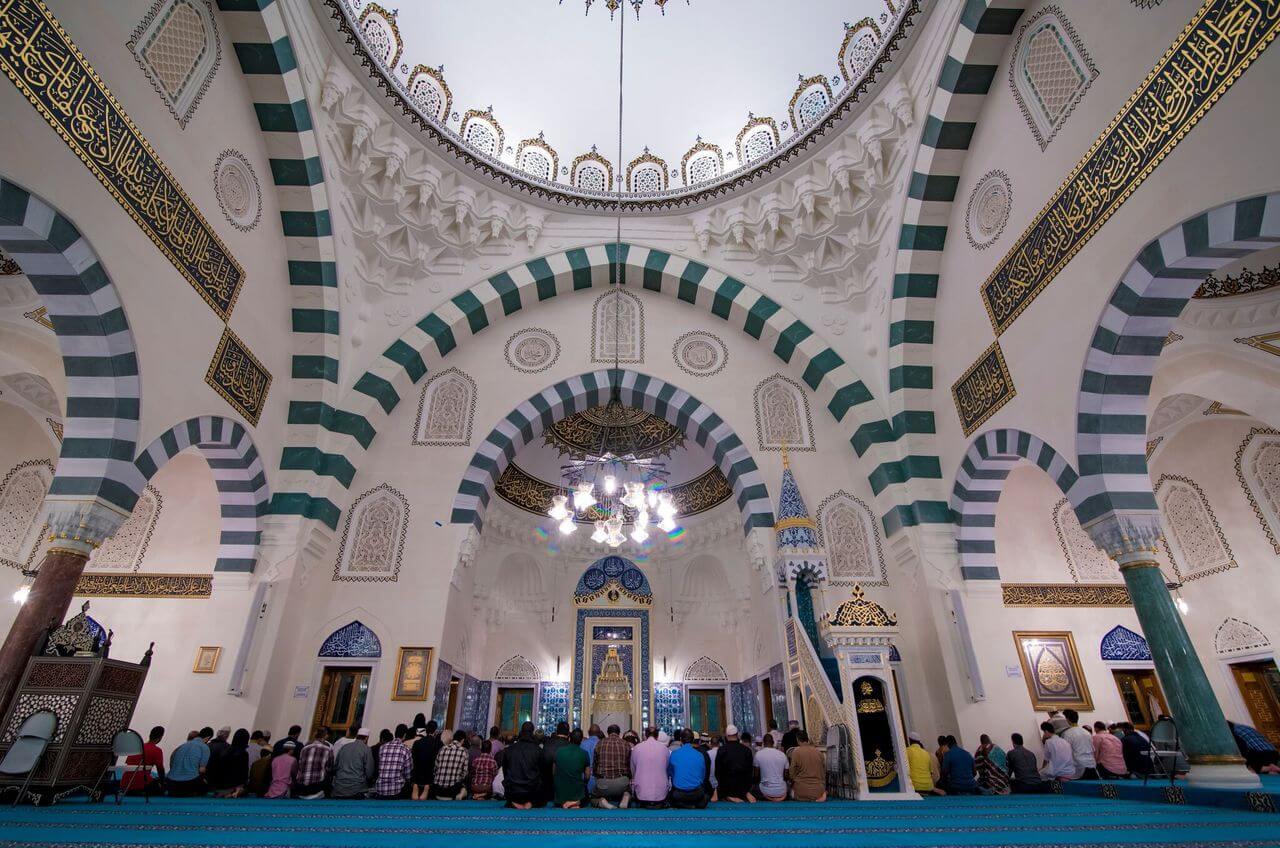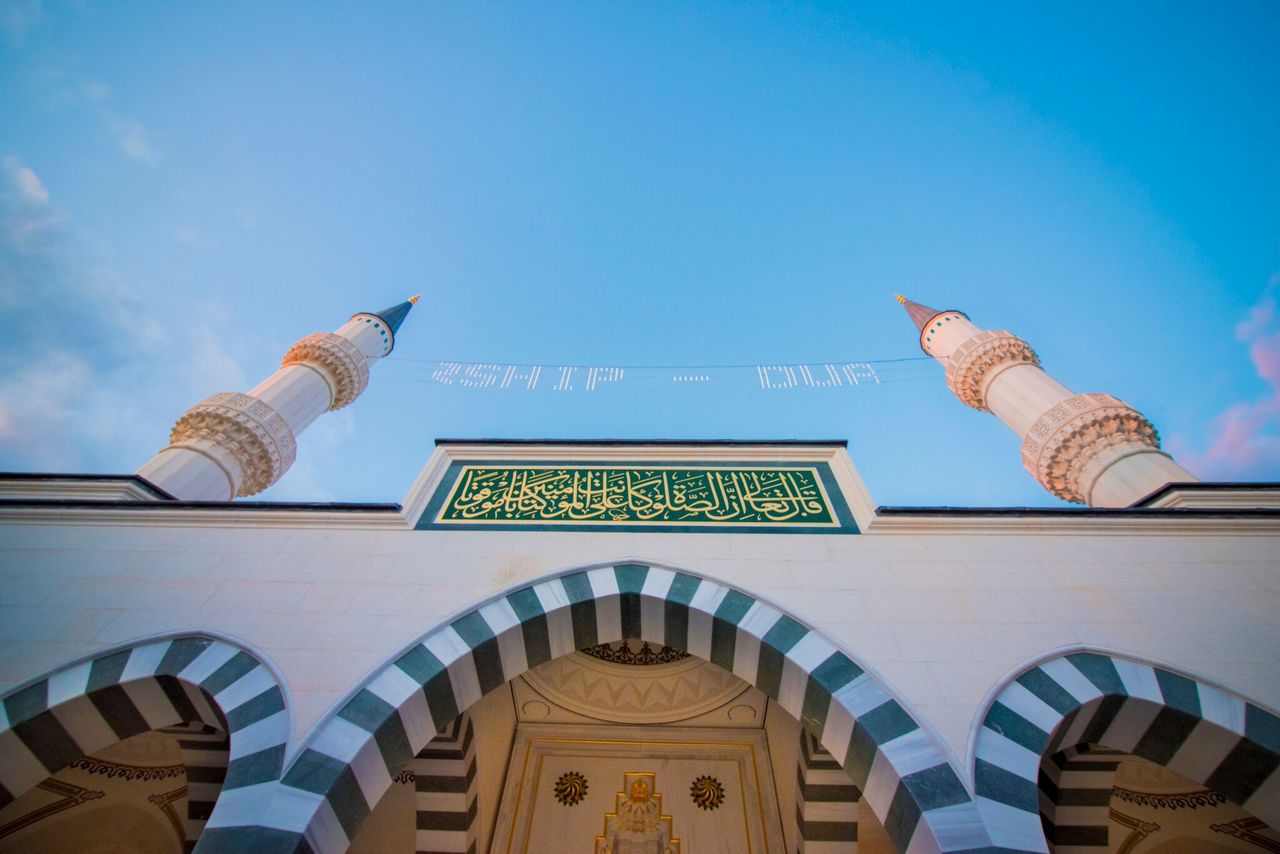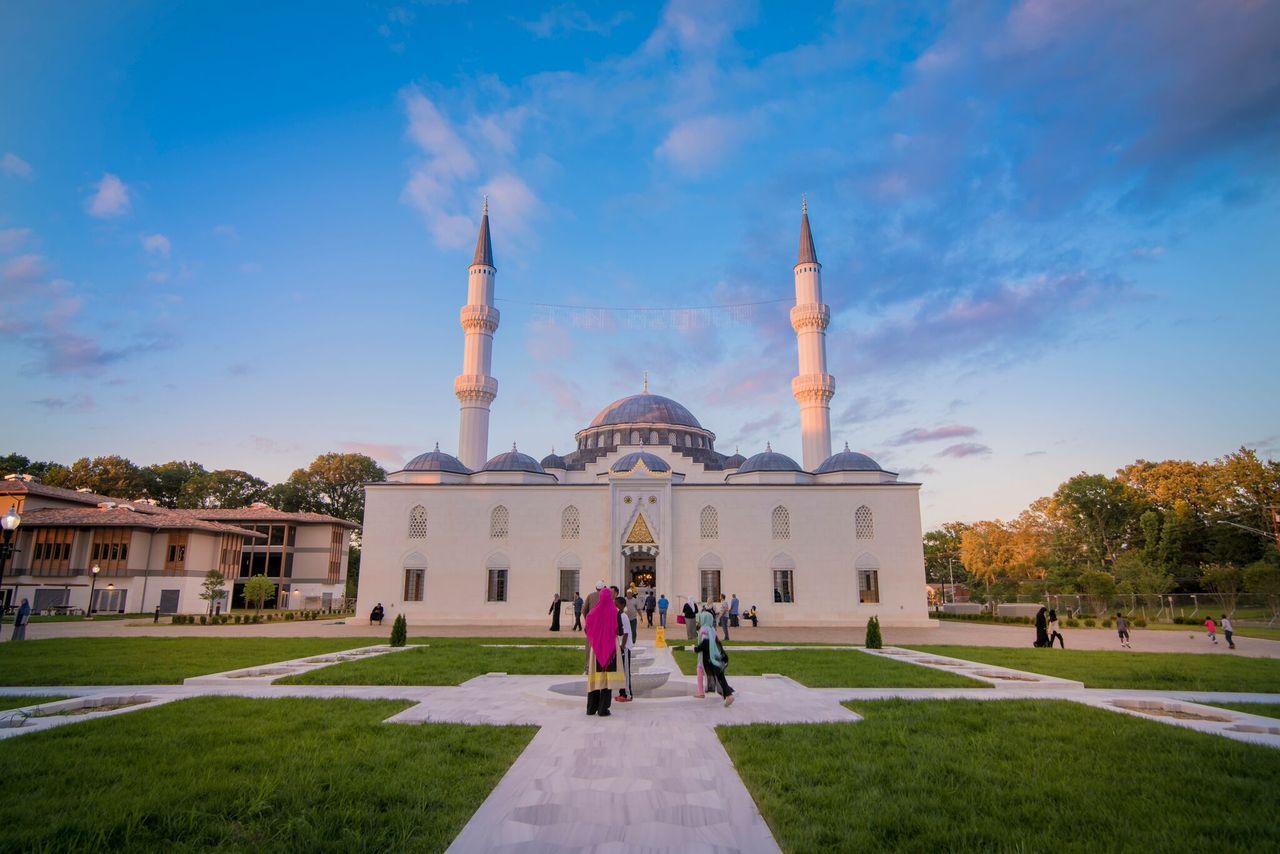

//

//

//
THE MOSQUE
The Mosque in Islamic Civilization
The mosque has an important place in Islamic civilization and in the development of its architecture. Mosque architecture began in Islam with the Masjid al-Nabi in Medina. While retaining its basis and spirit as established by the Prophet, it has evolved over history. The Masjid al-Nabi, which was founded by the Prophet and gave direction to mosque architecture in Islam, was at the same time the first madrasa (school of Islamic law) for Muslims. From the beginning, there were places in the mosque or masjid, that is, places of the Ashab al-Suffa (People of the Portico), where all Muslims were taught that Islam could not coexist with ignorance and that the enlightenment of society derived from knowledge and wisdom. In Islamic civilization, the mosque or masjid was baytAllah, meaning “the house of God.” This point of view expressed the importance of mosques and masjids and the sanctity that was attributed to these places. This concept ensured that the most beautiful and largest buildings in Muslim lands throughout history would be mosques. They were built in the center of the city and the settlement plan of the city was arranged according to the placement of the mosque. The most recent innovations discovered in art and architecture were reflected in mosques; and each mosque became an example of this tradition which flourished over the generations. Mosques, which developed architecturally and aesthetically and were made beautiful in each era, occupied a special place in the intellectual and ethical life of society as centers where knowledge, especially religious and spiritual knowledge, was taught and learned. The principles and concepts which breathed life into Islamic civilization were taught and learned here. Spirituality and the spirituality of places of worship have created and developed civilization. The deeply rooted and noble civilization that arose from the mosques always called upon humanity to be brothers in creation in a common religion; and whereever it spread tranquility, peace, and brotherhood prevailed.
The Mosque as the Heart of the Center
Architectural Features
Because the American Religious Center is a mosque-centered project, the building at the very heart of the Center is the mosque. The mosque was built in the style of sixteenth-century Ottoman architecture. The most important feature of sixteenth-century Ottoman architecture is its combination of aesthetics and functionality. Ottoman architecture had an important style which brought together art, aesthetics, and functionality in the construction of places for daily life. The most significant feature of mosque architecture in that period was to ensure unity in space by using the central dome system. Much larger and centralized spaces were created by using a system of construction that employed a central dome supported by adjoining half-domes and small domes.
In the Mosque of the American Religious Center, in the space enlarged by the use of a half-dome on the qibla-side (the side facing Mecca) of the central dome and five small domes on each of the other three sides, a unity is created and a large and open place is provided. The weight of the dome is born and transferred equally by placing it on four “elephant feet” (pillars) in conformity with traditional Ottoman architecture. The large and small domes are supported by arches, again in conformity with traditional architecture. Four marble colums carry the weight of the four elephant feet in addition to that of the small domes at the sides. Each of these columns was brought from the Turkish provinces of Istanbul, Eskişehir, Afyonkarahisar, and Tokat, which are famous for marble. Thanks to this, it is possible for 760 people to worship at the same time in the covered area. The mosque also has a spacious courtyard. The sides of the courtyard are each covered with five small domes creating a space that is half covered. The mosque has two minarets each of which has two galleries. It has the distinction of being the only mosque in American with two minarets. In the covered area and courtyard together it is posible for 3,000 people to worship at the same time.
In the interior decoration and ornamentation, traditional motifs are used, but original features are also exhibited. In order to add richness to the decorated spaces, above all where there is Arabic calligraphy, inside the mosque, the technique of gold leaf has been used. The mihrab (prayer niche) and the walls on each side of it are covered with tile. Taking into consideration the fact that decoration has certain functions in adddition to philosohical thought, the Arabic inscriptions have been made so that one can read thim in the depth of the domes and they reinforce the architecture. While the inscriptions call forth the relationship of multiplicity and unity, mukarnases (“stalectite” decoration) are used for the transition to different geometric shapes, such as from quadrilateral to multilateral. Decoration, in which emphasis is given to the duality of the traditional and modern and to the art of calligraphy—which is considered to be non-figurative and “abstract imagry”—and “physical and moral architecture,” which reaches resolution in pure Turkish Islamic architecture in the concept of “simplified architecture,” are united.
The mosque, which is the most important structure in the project, covers an area of 1,879 square meters. Below the mosque is the Museum of Islamic Monuments in an area of 300 square meters. In addition there is a covered auto park with a capacity for 500 vehicles for visitors. The mosque is built of steel reinforced concrete on a foundation of piled compartments and is strengthened against earthquakes. High quality building materials, like stone and marble, have been set in place with steel-fitting machinery and no mortar was used. The interior acoustics of the mosque have been assured by the “empty spaces in the domes,” a method which has been used for thousands of years.
Introduction to the Places in the Mosque
Harim and Courtyard
In Ottoman mosque architecture, the mosque consisted of two primary sections, the harim or sanctuary and courtyard. The primary place of worship, which was covered, in a mosque is called the harim. In the dictionary harim has the meaning of something “forbidden, protected, inviolable, holy, and having a sense of respect.” The covered spaces in the mosque are called the harimbecause they are set aside as places of worship and thus sanctity is attributed to them. The harim section of the mosque in the American Religious Center is in the shape of a square and can accomodate 760 worshipers at the same time.
The section attached to the harim, the top of which is sometimes open and sometimes partly covered and in the middle of which is an ablution fountain, is called the courtyard. The courtyard of the central mosque is a partly covered space. Each of the four sides of the courtyard is enclosed with five small domes. These domes rest on marble columns. When the congregation is large, the courtyards can be used as places of prayer.
Mihrab
The place where the imam (prayer leader) stands in order to lead the congregation in prayer is called the mihrab. While praying, one of the obligations of prayer is to turn toward the Masjid al-Haram in Mecca. Thus, at the same time, the mihrab shows Muslims the direction in which they should turn during prayer. The mihrab is made of marble and gold leaf is used to decorate it. The upper part of the mihrab and both sides are adorned with tile brought from Turkey. On the pediment of the mihrab is a figure of the tree of life which symbolizes the 99 names of God.
Minbar
The place to which the imam ascends by steps to recite the sermon to the congregation on Friday and on holidays and which is located on the right side of the mihrab according to one who is turning toward the qibla (Mecca) is called the minbar. The speech that the imam gives to the congregation from the minbar relevant to that day is called the khutba. The minbar of the central mosque is made of marble and was brought fully assembled from Turkey.
Kursi
The place from which the imam addresses the Muslims who have come to the mosque on religious subjects is called the kursi(chair). The kursi of the central mosque is composed entirely of wood and was made in Turkey. For the adornment of the kursi thekündekari technique of woodworking (the tongue-and-groove panelling of polygons and stars set in a strapwork skeleton), which is the traditional art of wood decoration, and inlaid mother-of-pearl are used.
Minaret
In the religion of Islam, all Muslims are required to pray five times a day. Each prayer is referred to by the name of the time of day when it is to be done. Muslims are alerted to the times of prayer by the adhan (call to prayer). The high place from which the call is made in order for it to be heard over a wide area is called the minaret. The central mosque has two minarets with two balconies. The galleries are adorned with mukarnas and acquire an aesthetic beauty in their spatial transitions.
Shadirvan
Fountains, called shadirvans, were usually built in the middle of the courtyards in mosques for ablutions. In addition to their function of providing water for ablutions, they were also built for aesthetic purposes and to add spiritual tranquility to the space with the sound of water. In the courtyard of the central mosque there is a shadirvan made of marble. The copper faucets are made in traditional style.
Mahfil Area
The spaces created for various purposes in the sanctuary section of mosques are called the mahfil (assembly or meeting area). In historic mosques it was common to set aside special places for the use of the muezzins and sultans. The places where the women worshiped were also called the mahfil. In the central mosque there is a mahfil with an area of about 130 square meters. The ceilling of the mahfil is covered with five small-scale domes. The domes are decorated with geometric patterns.
Mahfil of the Muezzin and the Place at the Back of the Congregation
The mahfil of the muezzin is the name given to the special place used by the muezzins while praying with the congregation. In order for the voice of the muezzin to be easily heard by the congregation, this place is usually somewhat elevated. Those who cannot pray with the congregation perform their prayers in a specific area called “the place at the back of the congregation.” Themahfil for the muezzin and the place at the back of the congregation have been designed, respectively, for the areas to the right and left just inside the main entry door of the central mosque. The ceilings of these spaces are decorated with wood in geometric patterns.
Domes
In traditional architecture, the archtectural element in the form of a half sphere which was used to create large covered spaces was called the qubba (dome). In traditional Ottoman architecture, domes became in indespensible element. According to Turkish Islamic tradition the concept of the cosmos or all creation was reflected in mosque architecture. In this connection, the dome symbolized the firmament. In the central mosque, the domed system is also used in conformity with traditional architecture. Over the area of the sanctuary, there is a main dome on each side of which are five small domes. In order to provide light inside the mosque, there are windows around the rim of the main dome. This dome is adorned with Arabic calligraphy, one of the traditional decorative arts of Islam.The Qurʾanic verse “Purity of Faith” (al-Ikhlas), which contains the fundamental assertion of God’s unity, is inscribed in the center of this dome. As for the small domes, they are also adorned with traditional decorative elements.
Arches
The arch is the connecting vault which ties two colums or pillars to each other in the form of a half circle overhead and which causes the weight of the walls above them to be transferred to the pillars on the two sides. In order to increase the aesthetic beauty of the mosque, the arches are painted white and green. Muqarnases which contain different geometric patterns are used to ensure the transition between the columns and arches.
Muqarnas
The muqarnas is a form of decorative art in Islamic architecture. It is a decorative art consisting of geometric forms which is used at transition points in spaces having different surface features. In the central mosque, the wall dome transition points and the column arch transition points are decorated using the muqarnas technique.
Wood Doors
The wood doors of the central mosque in the American Religious Center have the distinct feature of being places where traditional Islamic decorative art is exhibited. The doors are made using the kündekari technique of woodworking, which is the traditional art of wood decoration. Kündekari is a technique which is used to create flat surfaces by bringing together, without the use of nails or glue, small pieces of wood cut in such shapes as octagons, pentagons, and stars. The mosque has six wood doors which open to three areas of the sanctuary and three areas of the courtyard. The appearance of these doors is enriched with inlaid mother-of-pearl.
Ablution Rooms
Mosques are the places where Muslims worship. In Islam, certain practices must be followed before worship. One of them is to wash one’s self and perform an ablution. For this reason there ablution rooms in every mosque. There are separate ablution rooms for men and women on the ground floor of the central mosque.
//
No comments:
Post a Comment